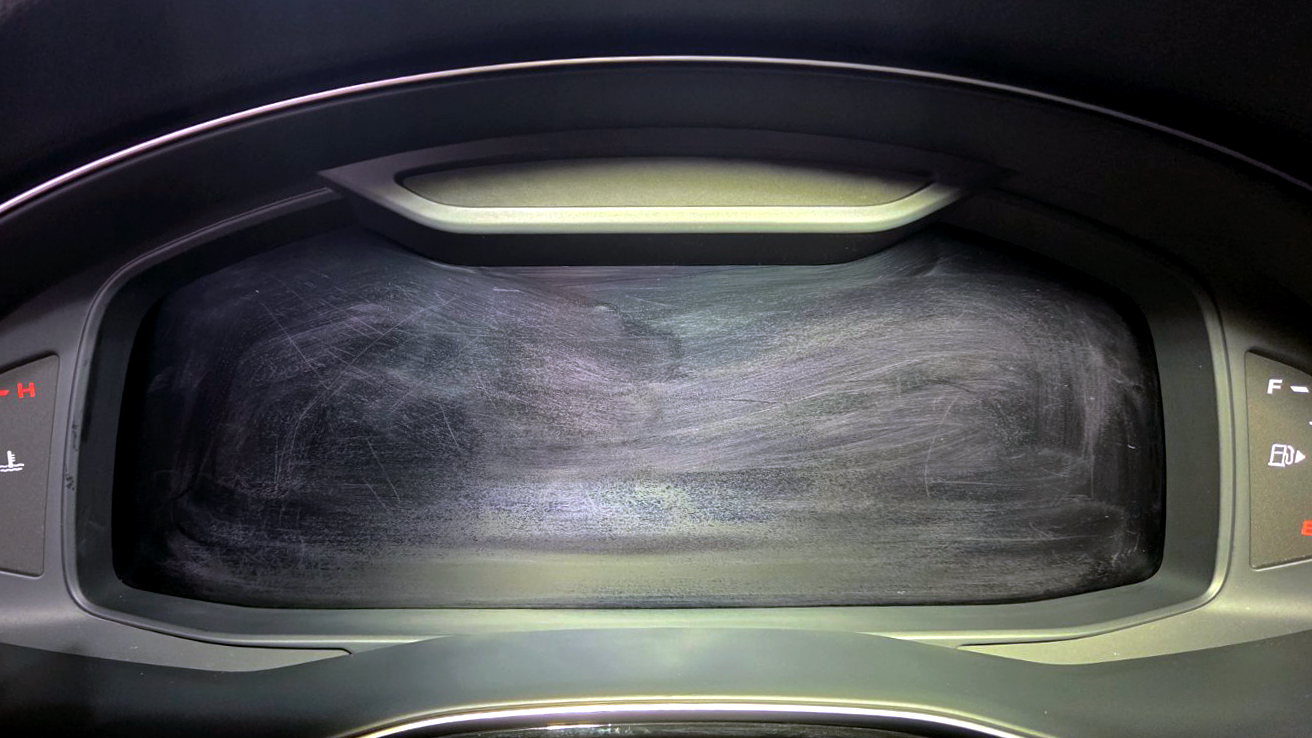Anti-glare coating of car displays — is an ultra-thin functional layer applied to the surface of the glass of multimedia systems and digital instrument panels. Its purpose is to reduce light reflections and improve image readability under any lighting conditions. Thanks to this, the information on the screen remains clear and high-contrast even under direct sunlight.
Over time, the anti-glare coating wears out: the screen loses transparency, becomes cloudy or “polished,” and rainbow streaks and uneven gloss appear. Such defects are often mistaken for dirt or a malfunction of the touch layer, while in reality, it is the anti-glare coating or a combination of optical layers that is damaged.
The photo below shows a real-life example: the instrument cluster of an Audi Q7 with visible wear marks of the surface anti-glare coating.

Where anti-glare coatings are used (which vehicles)
The anti-glare layer is applied in most modern vehicles, especially those equipped with large and high-contrast displays:
- Premium segment: Audi, BMW, Mercedes-Benz, Porsche, Lexus, Volvo.
- Digital brands: Tesla, Polestar, Lucid.
- Mid-range and mass-market: Volkswagen, Hyundai, Kia, Toyota, Honda, Ford, Chevrolet, and others.
The higher the display quality and the larger its diagonal, the more noticeable the deterioration becomes when the anti-glare layer is damaged.
Why the anti-glare coating gets damaged
- Improper cleaning. Using household cleaning agents, alcohol, ammonia, or abrasive fabrics damages the optical layer.
- Mechanical friction. Frequent touches, rough wipes, rings, or nails create microscopic scratches.
- Overheating. High cabin temperatures and sunlight accelerate coating degradation.
- Dust and abrasive particles. Even fine sand acts like sandpaper when wiping the screen.
- Insufficient factory coating durability. Sometimes the issue results from the use of low-resistance materials during manufacturing.
Service life of the coating
- Typically: 1–3 years under careful use.
- With intensive use: first signs of wear may appear within 6–12 months.
- On premium displays: defects are more noticeable due to high contrast and resolution.
Vehicles most prone to the issue
Visible wear of the anti-glare coating is most often observed in Audi, BMW, Mercedes-Benz, and Tesla — mainly due to the large display area and high screen brightness. In budget models, screens are less sensitive to optical distortions, so the defect is less visible.
Recommendations for screen care
- Use only microfiber cloths. Lint-free wipes protect the surface from micro-scratches.
- Apply professional cleaning solutions. Only special screen-cleaning fluids without alcohol or solvents.
- Do not apply pressure. Wipe the screen gently without pressing on the glass.
- Avoid direct sunlight. Whenever possible, park in the shade or use sunshades.
- Keep your hands clean. Grease and cosmetics accelerate the degradation of optical layers.
What to do if the anti-glare coating is already damaged
Step 1 — Complete removal of the residual coating
Caution! Aggressive solvents may damage the plastic or adhesive around the screen.
- Turn off the multimedia system.
- Using a microfiber cloth slightly moistened with isopropyl alcohol (70%), gently remove the damaged coating areas.
- Wipe the screen dry.
- Do not apply new compounds — it’s better to proceed with protection.
Step 2 — Install Pixsel protective glass
It provides long-term protection, improves readability, hides minor defects, and increases scratch resistance.
How to choose Pixsel protective glass
- Take accurate screen measurements. Measure width and height excluding bezels.
- Select the surface type. Matte — reduces glare; Glossy — preserves color depth and brightness.
- Choose the material. Thin tempered glass (0.2–0.4 mm) or hybrid multilayer polymer with high hardness.
- Pick a product designed for your specific car model.
Why choose Pixsel
Pixsel specializes in manufacturing protective glass specifically designed for automotive displays.
- Optimal glare reduction while maintaining brightness and contrast.
- Precise fit to the screen geometry.
- Reliable protection against scratches and microcracks.
- Custom manufacturing available for specific car models.
Recommendation: If your display shows cloudiness or micro-scratches, install Pixsel protective glass — it’s effective, elegant, and extends the device’s service life.
Step-by-step installation of Pixsel protective glass
- Preparation. Turn off the multimedia system, prepare wipes and a dust-removal kit.
- Cleaning. Remove dirt with a soft microfiber cloth.
- Fitting. Align the glass without removing the protective film.
- Application. Remove the protective film and carefully install the glass from the center outward.
- Check. Ensure there are no air bubbles and that touch sensitivity functions properly.
Conclusion
Once the anti-glare coating is worn out, restoring the factory layer is impossible. However, removing the remaining coating and installing high-quality protective glass fully compensates for the defect and enhances readability. Pixsel offers ready-made solutions tailored to specific car models — practical, aesthetic, and durable.